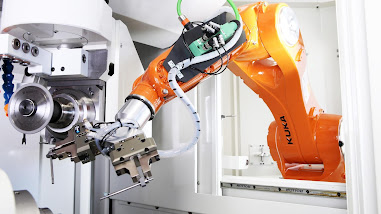Advanced Machining with Industrial Robots
Let’s first understand what is machining?
Machining is a terminology broadly used to describe a phenomenon of material removal from any workpiece. Machining can be further classified into different categories:
Traditional Machining:
- Turning
- Milling
- Drilling
- Grinding
Non-traditional Machining:
- Waterjet cutting
- ECM: Electrochemical Machining
- EDM: Electrical discharge Machining
- AFM: Abrasive Flow Machining
- USM: Ultrasonic Machining
Since the early days, machining is mostly by using a turning or a milling machine. The milling process requires a tool that rotates at the desired RPM and takes away material from the stationary part. The turning machine operates exactly the opposite, the part is rotated around an axis and the tool stands still (most of the time) and removes material from the rotating part. There are other intricacies, but this is fundamentally how it operates. We have industrial metal working tools also
If we look at the construction of the machines, these machines can be huge and are normally placed on a shop-floor with an appropriate power supply, air supply, and coolant fluids. Different parts are placed ''inside'' the machines. So the machining area can be limited to this sometimes much smaller space.
There are other machines that are a little advanced which are called CNC machines. These are automated machines and operate on a particular program and work on the part that is placed in the workspace. The CNC market is always evolving, by bringing in new models, adding axes and ways to do the job more efficiently. Nowadays, CNC machines are also furnished with pallet changers as well as tool changers, which helps in the seamless flow of operations.
Machining through robots
The manufacturing industry is utilizing the above methodologies since ages. However, the birth of disruptive technologies like machining through robots has provided a huge leap ahead. The machining industry has been familiar with the robots for a little while now, mostly to do production work. Although, with a lot of technological advancement, industrial robots are now ready to take over the machining. In other words, the use of Industrial robots for machining complex parts and shapes with various rigidities is the best alternative.
Robot machining can be a game changer when there is a requirement of more complex shapes in the manufacturing process. Sometimes, it gets very tough to achieve the desired geometry using the traditional machines. On the other hand, in some applications it is not possible to use milling or turning as the part which has to be machined is too big to be fit on to the traditional machines.
After looking at the above situations, the best solution is to use industrial robots with more than 5 axis. Depending upon the application, a lot of rigidity may be required. While using the robot, one can omit the problem of complexity but will face the problem of accuracy. You want the robot to be as accurate as possible and the factors including backlash and robot warmup have to be regularly monitored and reoriented for best results. To make it more precise one can use vision system, it will help the robot to get to the right spot at the right time.
Visionary systems
For achieving best results in machining, the machine should be rigid and that is the key part. Using Robots for work poses some challenges, as the force applied is huge and it creates some kick back. This can result in compromise of accuracy. Hence, to omit those errors robots has to be repositioned exactly.
Exclusive Tips : lathe chuck jaws
To achieve this, external vision systems have been developed, which will reposition the robot at the right spot when problems occur. The path of the robot for the operation is pre-programmed and the vision system helps the robot to remain to be on the desired path for better accuracy and precision.
Aerospace machining using robot milling
On an aircraft, rivets are used to fix the cabin to the aircraft frame. Earlier, this was performed manually using drills by the workers. These days composites like titanium are used in the manufacturing of aircraft and it is nearly impossible to drill the hole manually. Manufacturers are now using advanced robots for performing the process with ease. Also, they are using a vision system to make it more precise.
This is just the beginning, as more and more complexity in machining will be witnessed and we will have to opt for new disruptive technologies to stay ahead of the game.
Also Read This Blog Post : Brief Information About Collet jaws ?




Comments
Post a Comment